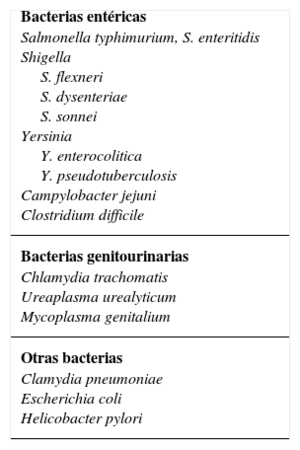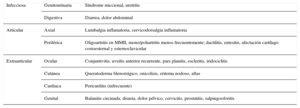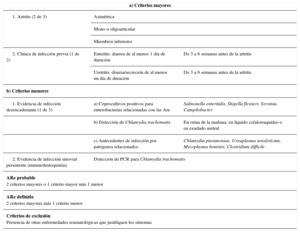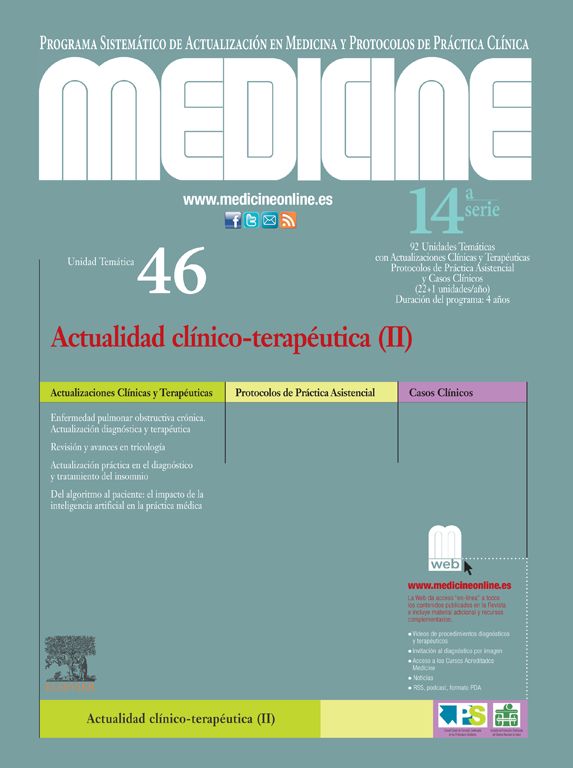La artritis reactiva es una inflamación sinovial que se produce unos días o semanas después de una infección gastrointestinal o genitourinaria por unos gérmenes determinados, presentando una fuerte asociación con el HLA-B27. Se trata de una enfermedad poco frecuente, englobada actualmente dentro de las espondiloartropatías, aunque no se dispone de unos criterios diagnósticos aceptados de forma universal.
PatogeniaSu patogenia todavía no se conoce del todo, aunque diversos trabajos han mostrado recientemente la implicación de las células T, con la activación del eje IL-17/IL-23 y diversas citoquinas como el TNF-alfa y la IL-1.
Manifestaciones cínicasLa clínica articular debe manifestarse entre 7 días y varias semanas tras la infección, y suele presentarse como una oligoartritis en los miembros inferiores. Además, son características ciertas manifestaciones extraarticulares como la balanitis circinada y el queratoderma blenorrágico.
DiagnósticoEl diagnóstico debe hacerse intentando identificar el germen causal mediante cultivos cuando sea posible, serología o pruebas moleculares como la PCR.
TratamientoSe debe instaurar antibiótico en caso de infección activa. Para la clínica articular, se deben emplear los AINE como primera línea, seguidos de corticoides intraarticulares/orales. Si la artritis persiste más de seis meses, se considera crónica y, en este caso, estarían indicados según su severidad fármacos modificadores de la enfermedad y/o anti-TNF-alfa. En caso de artritis por C. trachomatis se ha demostrado la eficacia del tratamiento combinado con antibióticos.
Palabras clave
Reactive arthritis is a synovial inflammation that occur days or weeks after a gastrointestinal or genitourinary infection by specific germs. It has a strong association with the HLAB27. It is a rare disease, included within the Spondyloarthropathies, although some universally accepted criteria is not available.
PathogenesisIts pathogenesis is not yet known, although several studies have shown the involvement of T-cells, with activation of IL-17/IL-23 axis and various cytokines such as IL-1 and TNF-alpha.
Clinical manifestationsClinical manifestations must occur within seven days and several weeks after infection, and usually occurs as a oligoarthritis in the lower limbs. Extraarticular involvement as circinate balanitis and the keratoderma blennorrhagicum may be present during the acute or chronic phase of illness.
DiagnosisThe diagnosis of reactive arthritis should be trying to identify the causative germ by crops wherever possible, serology or PCR molecular test.
TreatmentThe antibiotic in case of active infection should be set up. For the clinical joint, use NSAIDS as first line, followed by corticosteroids intraarticular/oral. If the arthritis persists more than six months, it is considered chronic. Anti-TNF-alpha and/or disease-modifying drugs may be used according to their severity. In case of arthritis by C. trachomatis has demonstrated the efficacy of combined treatment with antibiotics.
Keywords
Identifíquese
¿Aún no es suscriptor de la revista?
Comprar el acceso al artículo
Comprando el artículo el pdf del mismo podrá ser descargado
Teléfono para incidencias
De lunes a viernes de 9h a 18h (GMT+1) excepto los meses de julio y agosto que será de 9 a 15h




